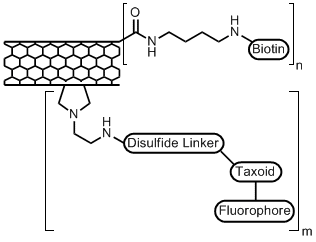Sunday, May 18, 2008
Student Union Building, Upper (Queensborough Community College)
162
Design, Synthesis and Biological Evaluation of a Novel Tumor-Targeting Drug Delivery System Based on Functionalized SWNT
A SWNT-based biotin-taxoid conjugate, in which biotin was introduced as the tumor-targeting moiety, was designed and synthesized for evaluation of its efficacy in tumor-targeting drug delivery. The conjugate consists of a novel self-immolative disulfide-linker which releases the taxoid inside tumor cells by the action of intracellular glutathione. It has been reported that biotin receptors are overexpressed in various cancer cell lines, including leukemia cells. Thus, biotin is a viable tumor-targeting moiety. The cellular uptake of a fluorescence-labeled conjugate and the drug release were investigated by confocal fluorescence microscopy using L1210FR leukemia cell line. The successful real-time observation of the receptor-mediated endocytosis and the intracellular drug release of the fluorescence-labeled biotin-SWNT-taxoid conjugate will be presented.
